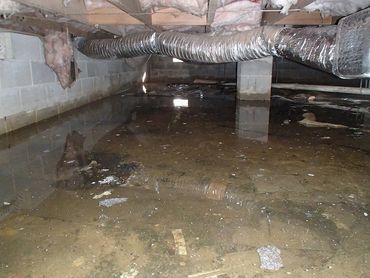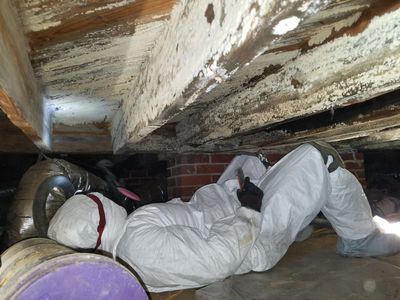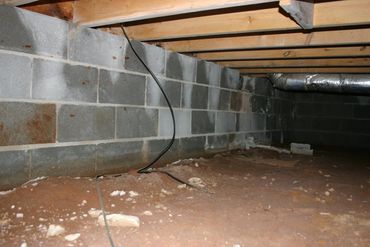Crawl Space Waterproofing
WE INSTALL:

Vapor Barriers

Mold Spray Treatments

Sump Pumps and Drainage Pipe

Encapsulations

Dehumidifiers

Crawl Space Doors

Insulation Removal

Gutter Downspout Extensions

Board Foam Insulation

Spray Foam Insulation

Floor Supports

Wood Repair
And We Install So Much More!
Crawl Space Waterproofing Done In 3 Steps!
Step 1 - Prevent Standing Groundwater


WHAT CAUSES STANDING GROUNDWATER IN A CRAWL SPACE?
To understand this we have to briefly go over how a crawl space foundation is built.
First, an excavator will dig a trench in the soil at least 16 inches wide and 10 inches deep and the trench will be filled with concrete and rebar. This is the called the footing that your home sits on.
Secondly, the foundation wall will be built on top of the footing; typically concrete block or solid concrete. Finally, an exterior footing drain (a black perforated pipe) will be placed around the perimeter of the foundation, next to the footing, and then gravel will be placed on top of it. The exterior footing drain is designed to capture groundwater after a rain event and take it away from the foundation out to daylight. You can see the exterior footing drain on the picture to the right. Some builders do not install exterior footing drains because certain cities and counties do not require it by code even though it is a good practice whether it's code or not.
QUESTION: If the grade around my house is pitched away from my house and my downspouts are extended out and away, why do I still have standing water under my house?
ANSWER: Remember, dirt is not waterproof, especially the dirt around your foundation. The dirt around your foundation is excavated fill soil that was broken up into billions of pieces therefore rain water flows through it easily and if you do not have an exterior footing drain or your existing footing drain is filled up full of mud, then the rain water has no where else to go but INSIDE YOUR CRAWL SPACE.

Typically exterior footing drains have at least 2 feet or so of dirt on top of them. Every time it rains, the rain water enters the exterior footing drain along with dirt and mud. Over time these drains fill up full of mud and fail. View the picture to your right. Now you have a groundwater problem.
IF STANDING WATER REMAINS UNDER YOUR HOUSE THE POTENTIAL DAMAGES ARE:
1) Foundations sinking. Mud has a lot less bearing capacity than dry dirt.
2) Mold growth. Mold needs 60% humidity to grow and there will be constant evaporation from water.
3) Wood rot. Wood that is constantly absorbing humidity from standing water will begin to rot.
WHAT ARE MY REPAIR OPTIONS TO PREVENT STANDING GROUNDWATER?
1) Extend the downspouts.
No warranty. Does not address rain water seepage around the entire property.
2) Regrade the soil around the house.
No warranty. Dirt is not waterproof.
3) New exterior footing drain.
Digging up around the whole foundation with an excavator and installing a new exterior footing drain is very expensive and has a 1 year warranty as dirt will enter the pipe slowly over time again. Replacing the exterior footing drain usually costs over $20,000.
4) Interior drainage pipe and gravel.
Has a lifetime warranty. Drainage installed inside the crawl space taken to a sump pump. Interior drainage pipe and gravel does not have several feet of dirt thrown on top of it so it will not clog up full of mud like an exterior footing drain would. This option usually costs somewhere between $2,000 to $7,000 depending on the amount of drainage pipe you need.
DISCLAIMER: Beware of the EZ Flow drainage pipe product. Many companies are now using this product to avoid using gravel rock in their interior drainage systems to save time and labor. EZ Flow is a 3" drainage pipe surrounded by foam pieces wrapped in a filter fabric sock. The EZ Flow drainage pipe floats in water so there is only 2 ways to keep it down in the ground. One, throw dirt on top of it to weigh it down. This can cause groundwater to go over the dirt and bypass the drainage pipe altogether or if the sump pump ever fails then the EZ flow will be full of water and because it floats it will eventually uplift and force itself out of the ground. Or Two, use rebar stakes or some kind of stake to pin it down to the ground. There are big problems with using rebar stakes. Steel rebar will begin to rust immediately and then eventually fail and all steel coatings eventually fail as well especially with constant ground contact. Also if the soil is too muddy then the stakes will slowly lift up out of the ground over time as water causes the EZ flow to float and create upward pressure on the stakes.
The below link will take you to the French Drain Man up in Michigan talking about EZ Flow
https://www.youtube.com/watch?v=vP3WLlLZ6N8

Step 2 - Remove Existing Mold
Please understand this, if you have existing mold and fungus in the crawl space and you keep the crawl space humidity under 60% all the time then the existing mold and fungus will go into a dormant stage. Once it is in dormant stage, there is no longer any new mold spore production and the wood framing will stop rotting. But, the wood framing will look the same.
This could be a problem when you go to sell your home in the future and you have "dormant" mold and fungus on the wood framing. Home inspectors will still take pictures of mold and fungus, dormant or not.
WHAT ARE MY REPAIR OPTIONS TO REMOVE EXISTING GROWTH ?
1) Soda Blasting. Soda blasting is like sand blasting but you are using baking soda instead of sand. It will physically remove the mold and fungus off the surface of the wood framing. It will not remove the roots in the wood or remove any mold stains so often times the wood looks the same. Soda blasting under a crawl space releases a tremendous amount of dust particles in the air as the soda is being blasted into thousands of pieces. This soda dust will make it's way upstairs. It is completely unavoidable to not have soda dust particles upstairs after soda blasting in a crawl space so expect a clean up job by yourself after it's done. Soda blasting is also an expensive process. Soda blasting costs usually range from $2.50 a sq ft to $3 a sq ft or higher.
2) Sanding or HEPA Vacuuming. This is the slowest and most time consuming process available. There is an incredible amount of labor involved with sanding or vacuuming by hand every square inch of wood framing in a crawl space. This will remove mold and fungal growth on the surface. Without any kind of spray treatment you don't kill the fungal root system inside the wood.
3) Mold Spray Treatments. Spray treatments do not remove mold and fungus. They just kill it only. Many times the wood framing looks the same after just a spray treatment. Can still be detectable by a home inspector in the future. Most spray treatments cost less than $1 a square foot.
4) Scrub and Spray Treatment This method will kill the mold and fungus and physically remove the growth as well using scrub brushes. This method has far less dust being released in the air compared to soda blasting. Scrub and spray treatment usually costs close to $1 a square foot.

Step 3 - Keep The Humidity Under 60% (Prevent Mold)


WHAT CAUSES MOLD AND WOOD ROT IN A CRAWL SPACE?
One word. HUMIDITY. To be specific, humidity in excess of 60% will begin to cause mold and wood rot on the wood framing under a home. The EPA supports this fact on their website under lesson 3 and lesson 6.
https://www.epa.gov/mold/mold-course-chapter-2
The EPA states that humidity should be kept between 30-50% humidity.
SO WHERE DOES HIGH HUMIDITY COME FROM IN MY CRAWL SPACE?
1) Evaporation off the damp soil
2) Evaporation off the damp and porous concrete foundation walls
3) Through the crawl space vents if it's humid outside (Which in this area is very often)
4) From the 1st story floor framing. Floor framing is not air tight. If it gets humid upstairs, it will cycle down to the crawl space.
IF HIGH HUMIDITY REMAINS UNDER YOUR HOUSE THE POTENTIAL DAMAGES ARE:
1) Mold growth. Up to 50% of the air you breathe comes from the crawl space because hot air rises and your flooring system is not air tight. Crawl space air can also enter your duct work system through all the joints in the duct work. You can always test this by running a fog machine in the crawl space for at least 30 minutes.
2) Wood Rot. Replacing floor joists, girders, sill plates, and rim joists is very expensive. In fact, to replace all the wood framing in a crawl space under a 1,200 sq ft crawl space would exceed $30,000. This would include all joists, girders, sub-flooring, sill plates, and rim joists.
3) High Electric Bills. The air coming through your crawl space vents will be contacting all your sub-flooring. This means cold floors in the winter and more strain on your AC unit in the summer. Your AC unit spends more time trying to dehumidify the whole house instead of cooling the air which dehumidification is about 30% of an AC unit's working load.
WHAT ARE MY REPAIR OPTIONS TO KEEP HUMIDITY UNDER 60% (PREVENT MOLD)?
1) Ventilation or power vents.
Whatever it is outside comes into the crawl space. Obvious huh? If we lived in a dry climate like Arizona, then ventilation would keep crawl space humidity low but we live in the south which exceeds 60% humidity much of the year. That hot humid air mixes with all the dampness in the crawl space and the humidity goes way up. Ventilation is not a fix in this climate.
2) Plastic on the ground only.
This is often referred to as a vapor barrier on the ground. This may mitigate evaporation off the dirt but it does not address damp concrete foundation walls and open crawl space vents allowing hot humid air from outside coming in.
3) Encapsulation with a commercial grade dehumidifier.
This provides a written guarantee by us that new mold and fungus will not grow back in the crawl space. This blocks off all humidity sources: from the dirt, foundation walls, and open crawl space vents. The commercial dehumidifier collects any humidity coming from above through the flooring system or other areas. There are counties and cities in the south that are now recognizing the necessity of encapsulation and are making it the building code for new construction. This is a common choice for homeowners.
WHAT ARE THE BENEFITS OF ENCAPSULATION?
- Breathe easier. Vented crawl spaces have a huge negative impact on indoor air quality.
- Reduce the chances of costly floor repairs. Moisture rots wood and causes hardwood floors to buckle.
- Enhance comfort. Floors won't be cold in winter. House won't be muggy in summer.
- Lower energy bills. Crawl space encapsulation can reduce energy bills by up to 20%, according to Advanced Energy's research.
- Make your heating & cooling equipment and ducts last longer. An air handler and ducts in a vented crawl space will not last as long as equipment in a conditioned crawl space.
- Qualify for rebates and tax incentives. Some utilities offer rebates. The federal government has tax incentives for home performance improvements. Some state and local governments offer incentives as well.
- An encapsulated crawl space is an attractive selling feature. Potential buyers comparing two similar houses will find the one with an encapsulated crawl space more appealing.
Reference: https://www.energyvanguard.com/crawl-space-encapsulation-benefits
Keywords: seal crawl space crawl space repair crawl space waterproofing Clarksville TN

Crawl Space Waterproofing
Current Facebook Reviews
Need A Free Estimate? Contact Us!
Hours
Mon | 08:00 am – 05:00 pm | |
Tue | 08:00 am – 05:00 pm | |
Wed | 08:00 am – 05:00 pm | |
Thu | 08:00 am – 05:00 pm | |
Fri | 08:00 am – 05:00 pm | |
Sat | Closed | |
Sun | Closed |


